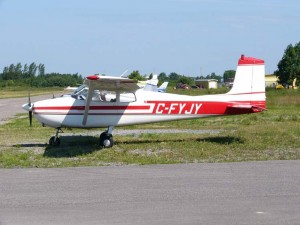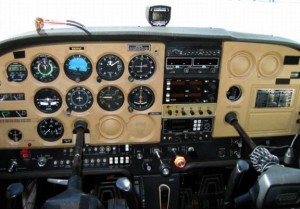Yesterday’s blog was about the Cessna 170. Today’s blog deals with the 170’s younger sibling, the Cessna 172. The Cessna 172 literally was born almost right after the 170. There were a couple of Cessna 171s, but they were of no real consequence.
During the latter time of the 170’s production run, a couple of engineers and mechanics were goofing off and slapped a nose wheel on one of the 170s. They joked around and called it the “171” because it looked funny. The landing gear was long and the tail of the airplane stuck up in the air really high. With the round tail of the Cessna 170, somehow the airplane just did not look right. As bad as the airplane looked, the engineers, mechanics, and pilots discovered something about this “Cessna 171.”
It flew extremely well and easily. A short time later, the Cessna 171 acquired a square tail, shorter gear legs, and a new designation—the Cessna 172. After the introduction of the 172 in 1956, sales took off. Before midyear, sales of the popular tricycle geared airplane completely out paced sales of the 170. By the middle of summer, Cessna decided to permanently kill the 170 line.
What Cessna achieved with the 172 is phenomenal. The 172 is one of the safest and easiest airplanes ever offered to the public. Indeed, Cessna promoted the airplane as being so safe, “anyone could fly.” Over the 56 years making up the life of the airplane, the statistics bear out the truth of the 172 being the safest ever.
There are a couple of things which make the airplane so safe. First, it is extremely easy to fly. Secondly, it flies slowly on the low end of its performance envelope. Third, the airplane is extremely strong with maneuvering speeds actually designed to be faster than the aircraft’s normal cruising speed. Essentially, a pilot has to work really hard to get hurt in the Cessna 172.
Since 1956, Cessna has produced over 43,000 units of the 172. When the airplane came out, approximate cost per unit was $8700. Today, a 2010 Cessna 172S costs more than $300,000. Much of the expense of the S-model is attributable to the advanced avionics and all glass panels of the Garmin G-1000 units installed in the airplanes.
Regardless of how the airplane is equipped, the 172 has always delivered sound performance and safety for the buck. For your operational dollar, you could find no safer an airplane than the 172. Additionally, she’s a somewhat comfortable old airplane in which to enjoy an afternoon cross country.
-30-
© 2010 J. Clark




I trained in a 152. Last month I flew a 172 for the first time and couldn’t believe how easy it flew. Everything about it was fun. This was an older model with out the glass cockpit but I loved the avionics it did have compared to the 152 I flew. I hope to take a 172 up tomorrow to finish getting checked out so I can rent it if the weather cooperates.
I like tailwheel airplanes the best, but a good ol’ 172 (and I emphasize old here, 1956-1962) are great airplanes. They are the touring models of the airplane, if you will. In those years, there were fewer avionics and instruments which allowed for a lower instrument panel. This gave the occupants up front a very unrestricted view out the front – it is like a flying picture window. Another thing I like about the early airplanes is the use of the six-cylinder Continental C-145 or O-300 engines.
Pingback: 100,000 Airplanes |
In the mid 1950s or so, Met-Co-Aire developed a nosewheel kit for at least the Cessna 140, and perhaps the Cessna 170. The 140 conversion was informally called a Cessna 141. Perhaps someone at Met-Co-Aire can tell us how many kits were sold. I doubt that any of the converted aircraft still exist, and any that survived were converted back to a tailwheel.